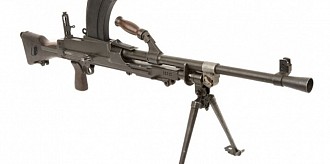Combat vehicles / Reconnaissance / Landsverk Unimog
Landsverk Unimog
General Facts
- TYPE
Reconnaissance vehicle - ORIGIN
 Sweden
Sweden - NICKNAMES
Pansarbil Unimog (manufacturer's designation) - DESIGNED
1958 - DESIGNER
Landsverk - PRODUCTION
Late 1950's - PRODUCERS
 Sweden - Landsverk
Sweden - Landsverk - QUANTITY
24 production vehicles plus at least 2 prototypes - UNIT COST
Unknown - CHARACTERISTICS
 Well armored
Well armored
 Limited costs
Limited costs
 Steering issues
Steering issues
 Cramped inside
Cramped inside
Introduction
The Landsverk Unimog is an armored reconnaissance vehicle of Swedish origin. The Landsverk Unimog was produced in small numbers and was actively used during the Congo conflict in the 1960's. It should not be confused with the German UR-416, which is also an armored vehicle based on the Unimog chassis.
Layout
The Landsverk Unimog is based on the commercial Mercedes-Benz Unimog 4x4 all terrain utility vehicle. The chassis has permanent front wheel drive and optional all wheel drive. The engine is mounted at the rear, resulting in a complex drive train. The exterior is made up of sloped steel armor plating.
Firepower
A total of six weapon options were available for the Landsverk Unimog and included armored machine gun turrets and SS-11 anti-tank missiles. However, production vehicles were only fitted with pintle mounted machine guns. Those used by Ethiopia were fitted with two Madsen-Saetter medium machine guns. In Irish service a single M1919 or Bren was installed.
Protection
The steel armor protects the crew from small arms fire and shell splinters. The armor plating is rather thick and well sloped allowing it to withstand point blank 7.62mm rounds. There are no NBC system or smoke grenade dischargers.
Mobility
The 4x4 chassis makes the Landsverk Unimog perform well off road. A standard Mercedes-Benz petrol engine provides propulsion. In Irish service it was found that the powered steering was unreliable and imposed a maximum speed of 50 km/h, although the vehicle is capable of 80 km/h.
Users
The Landsverk Unimog was ordered by the gendarmerie in Belgian Congo, who desired 24 units. Before these could be delivered conflicts erupted. Eventually 9 were acquired by the UN for Ethiopian use in the Congo. The remaining 15 plus 2 prototypes were eventually sold to Ireland. Since they were scrapped in 1986 the Landsverk Unimog is no longer operational.
Landsverk Unimog
The Landsverk Unimog is an armored car of Swedish origin that is based on the Unimog chassis. Prototypes of several versions were built, but only the open top variant with pintle mounted machine guns was produced.
- Specifications:
- Landsverk Unimog
| Type | Reconnaissance vehicle |
|---|---|
| Crew | 5 or 6 (driver, gunner, 3 or 4 passengers) |
| Length | 4.60 m |
| Width | 2.25 m |
| Height | 2.10 m (roof) |
| Ground clearance | 0.41 m |
| Weight | 5.2 t |
| Ground pressure | ? |
| Wheelbase | Wheeled chassis, 4x4, 2.38 m wheelbase, 1.66 m track |
| Turn radius | 10.4 m |
| Engine | Mercedes-Benz 2.2 L V6 petrol, 90 hp |
| Power ratio | 17.3 hp/t |
|---|---|
| Transmission | ? |
| Speed | 80 km/h on road |
| Fuel | ? |
| Range | ? |
| Wall | 0.35 m |
| Trench | ? |
| Gradient | 60% gradient |
| Fording | 1.0 m |
| Armor | Steel, up to 10 mm |
| NBC equipment | No |
| Night vision | No |
|---|---|
| Smoke | No |
| Remarks | - |
| Armament | 7.62mm Madsen-Saetter machine gun (2x) |
| Weapon1 | 7.62mm Madsen-Saetter machine gun on roof (2x) manual traverse and elevation non-stabilized |
| Weapon2 | - |
| Weapon3 | - |
| Weapon4 | - |
| Weapon5 | - |
| Weapon6 | - |





